|
|
This month’s newsletter provides information about new homeownership goals for Black residents, development plans around Howard University, and the DC Office of Planning’s (OP) racial equity action plan. Also be sure to check out the Engage in Planning Efforts and OP in the Community sections; we hope to see you at one of our upcoming activities, either virtually or in a neighborhood near you.
Sincerely,
Anita Cozart
Interim Director, DC Office of Planning
|
|
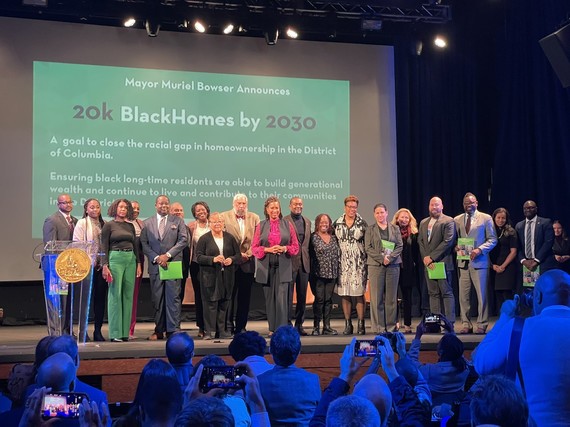 On October 3rd, Mayor Muriel Bowser, the Deputy Mayor for Planning and Economic Development, and the Black Homeownership Strike Force (BHSF) announced a new goal to make an additional 20,000 Black DC residents homeowners by 2030. The Strike Force also published a report that includes 10 recommendations to support the new goal. The BHSF’s recommendations will inform uses of the $10 million Black Homeownership Fund which was included in the FY23 Fair Shot budget.
Launched in June 2022, the Black Homeownership Strike Force included government and public experts in housing and financial counseling, real estate development and services, as well as representatives and advocates from the faith-based, senior, immigrant, and LGBTQ+ communities. The BHSF provided a platform for District residents to share their stories, experiences, ideas, and feedback regarding support needed to achieve homeownership in the District.
For more information and to read the Black Homeownership Strike Force’s report, please visit BlackHome.dc.gov.
|
|
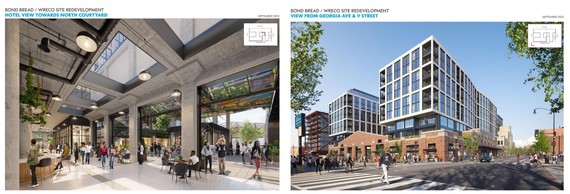 On September 22, the Historic Preservation Review Board unanimously approved the concept design for a mixed-use project that will bring new life and vibrancy to two former industrial buildings on Georgia Avenue adjacent to Howard University. The project will result in the rehabilitation and adaptation of two Art Deco landmarks - the Bond Bread Factory, an industrial bakery constructed in 1929, and the Central Bus Garage, constructed in 1930 as the storage and maintenance facility for the Capitol Transit Company’s bus fleet. With contemporary nine-story additions atop each building, the combined properties will house new ground-level retail, multi-family housing, a hotel, and an art-filled public courtyard park within the central atrium of the former bus garage.
The project will fulfill several goals identified in the 2005 Uptown Destination District small area plan that envisioned how the area could be developed into an 18-hour arts, entertainment and cultural district. Through building preservation and on-site interpretation, the project will preserve and celebrate the site’s historic character and the African American heritage of the neighborhood, while also providing the additional density and diverse uses necessary to achieve the desired vitality for the area. Modifications to the historic buildings’ facades will preserve existing fenestration patterns while achieving the urban design goals of opening the buildings up to the public and improving circulation through this large block and activating the abutting streets. The project will also include providing the long-sought east-west connection of W Street through the block from Georgia Avenue to 8th Street.
The project received community support from ANC 1B, the Pleasant Plains Civic Association, and the DC Preservation League. HPRB praised the design team’s careful approach to preserving not only the buildings’ exterior facades but also some of their distinctive interior features, such as concrete structural columns and exposed roof trusses, which will be highlighted in the new interior spaces. The Board concluded that “the project represents a thoughtful, creative and successful balance of preservation, new design and urbanism.”
The Bond Bread Partnership team is comprised of Menkiti Group, Fivesquares Development and Edens, with architectural plans prepared by Studios Architecture, landscape and urban design plans by David Rubin/Land Collective, and the preservation plan by EHT Traceries.
|
|
|
As part of Mayor Bowser’s Office of Racial Equity’s initiative to create a citywide Racial Equity Action Plan, OP is drafting an agency-level plan to ensure that our work advances racial equity in the District.
OP is hosting an open house to gather feedback from residents to inform its Racial Equity Action Plan.
Saturday, November 19, 2022
10:00am - 12:00pm
Martin Luther King Jr. Memorial Library, 901 G St NW
Drop by to learn more and to share your input about OP’s efforts to embed racial equity in its planning work and advance racially equitable outcomes in the District. For more information on the event and to sign up click here.
|
|
|
The DC Food Policy Council, a Mayoral Board of food system leaders led by the OP Food Policy Team, recently welcomed three new members. We are excited to work closely with them and learn from their expertise and experience as OP supports the Food Policy Council in advancing its strategic priorities.
|
|

DC's Office of the Deputy Mayor for Planning and Economic Development launched the second year of Nourish DC and a new round of $500,000 in grant funding. The Nourish DC Collaborative provides flexible loans, catalytic grants, and technical assistance to emerging and existing food business in DC to support the development of a robust ecosystem of locally owned food businesses, neighborhood vibrancy, and health equity in DC communities.
The application period ends on November 20, 2022. Learn more and apply here.
|
|
|
|
With the publication of the 2021 Comprehensive Plan, OP took the opportunity to reconsider our approach to urban design and better emphasize how it can positively guide development and promote better and more equitable social experiences. Over the next several months, the Urban Design Corner will highlight many of the forward-thinking policies found within the latest Comp Plan and how our team is working to make a lasting design impact on the District’s public spaces.
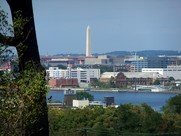
The first major policy section within the Urban Design Element is titled Shaping a Shared Civic Identity and centers on the idea that the design of our city tells a story about who we are as a collective people – as residents of the nation’s capital and our shared culture and values – and how these values have changed over centuries. In this regard, urban design must understand both A) the existing systems in place (from the natural topography and underlying ecologies to overlayed historic plans) and B) how these systems continue to influence and guide the pattern of the city today (in new developments and emerging waterfront communities but also in more established neighborhoods as well).
|
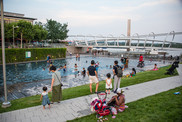
A key policy to pay attention to is UD-1.3 on Designing the Waterfront for the Next Century which seeks to prioritize diverse, resilient, and integrated neighborhoods along the city’s major riverways, provide physical and visual access to the water, and do so while respecting sensitive habitats, coastal flood zones and support innovation to adapt bolster adaptation to climate change. Through this, we seek to develop high-quality public gathering spaces along the Potomac and Anacostia Rivers that enable communities to directly experience the natural splendor of our waterfronts.
|
|
|
|
As the nation’s capital, Washington, DC is home to many monuments and memorials honoring individuals and events of national significance. But the District is also a city of neighborhoods and residents, with a local history of people, places and events deserving their own commemoration. In this section of our newsletter, we will highlight Commemorative Works from across District each month.
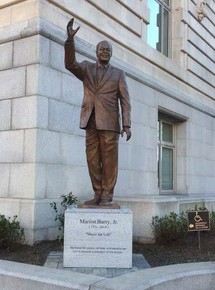
The statue of Mayor Marion Barry, dedicated in March 2018, is located at 1350 Pennsylvania Avenue NW on the grounds of the Wilson Building. Barry was elected to four-terms as Mayor of DC, earning him the title “Mayor for Life”. He was also elected to one term as At-Large Councilmember, four terms as Ward 8 Councilmember, and one term as At-Large member of the school board where he served as board president. Prior to being an elected official, Barry was a civic rights activist who began fighting segregation in his hometown of Itta Bena, Mississippi and included being president of the LaMoyne-Owen College chapter of the NAACP and first chairman of the Student Nonviolent Coordination Committee. In 1967, he co-founded Pride Inc., an organization that employed young men from DC’s most impoverished neighborhoods.
After Barry’s death in 2014, Mayor Muriel Bowser established a Commission to make recommendations on how to honor his legacy as a civil rights activists and politician. The 8-foot statue was commissioned by the DC Commission on the Arts and Humanities and Marion Barry Commission and sculpted by Steve Weitzman. The commemorative work was reviewed and supported by by the Commemorative Work Committee and approved by DC Council in 2017. The statue of Marion Barry is one of a few full-body statues of an African American in DC.
|
|
|
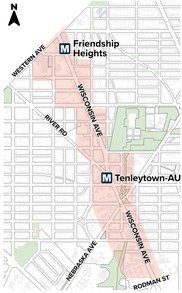
OP will be hosting a series of engagement activities for the Wisconsin Avenue Development Framework. On Wednesday, November 9, at 6pm, join us for a “What We’ve Heard” webinar that will cover community feedback we've heard so far and what to expect in the upcoming Community Design Conversations. Register for the webinar here and see below for details about the Community Design Conversations happening on November 19 and December 3.
Learn more and get involved in our community planning projects:
|
|
|
|
Join us at the following events where OP staff will be available to answer any questions and share information about OP’s work:
|
|
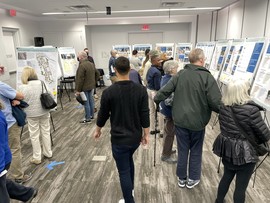 Connecticut Ave Community Design Conversation, October 22, 2022
|
|
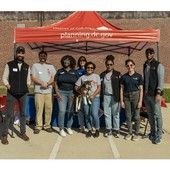 Ivy City Planning Day, October 22, 2022
|
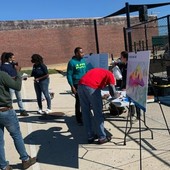 Ivy City Planning Day, October 22, 2022
|
|

OP is looking to hire a Community Planner and a Public Affairs Specialist to join our team. Learn more about the position and apply today!
Community Planner (Closing Date: 11/16/2022)
Public Affairs Specialist (Closing Date: 11/19/2022)
|
|
|
|
|
|